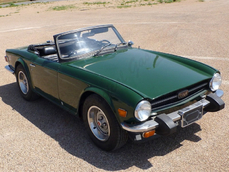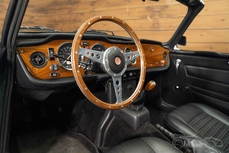Triumph TR6 Roadster 1971
Allgemeine Beschreibung :
In 1968 Triumph introduced the latest edition in their long-running line of “TR” roadsters. The TR6 replaced the stopgap TR5/TR250, sharing much of the older car’s underpinnings, and while not entirely new, the TR6 looked fresh and modern thanks to its heavily revised styling. Saving on development costs, much of the TR5’s Michelotti-designed body shell carried over, though it was extensively reworked with new front and rear clips, reportedly designed by Karmann. Power came from a 2.5-litre OHV inline-six, also shared with the earlier model. Home market TR6s made upwards of 150 horsepower thanks to Lucas P.I. mechanical fuel injection, putting the TR6 in the “junior E-Type” league. However, the complex system was finicky and difficult to set up correctly, so, in the interest of reliability, North American models relied on proven Stromberg carburetors, which were far simpler to tune to meet emissions regulations. Regardless of specification, the six had ample torque and a glorious soundtrack, propelling the light and nimble roadster along with ease. It quickly earned its place as a quintessential British roadster boasting iconic styling and real motorsports pedigree in an affordable package.
Showing just 7,378 miles from new, this 1971 TR6 is one of the best-preserved, most original examples we’ve ever encountered. Presented in the attractive shade of Saffron over New Tan upholstery, this unmolested TR6 is offered in time-warp original condition. According to the BMIHT Certificate, this car was completed on December 7th, 1970, and despatched to the North American market via British Leyland Motors Inc. of Jacksonville, Florida, about one month later. Options included the Saffron paint, tan trim, black vinyl hood, heater, black tonneau cover, and other minor fittings. It obviously lived a tranquil and pampered life, averaging fewer than 150 miles per year over the past 50 years.
The original paint is exceptionally well-preserved with a glossy and consistent finish quality. A few minor imperfections (such as the hastily applied adhesive in the door jamb) reflect British Leyland’s somewhat indifferent attitude toward build quality but highlight this car’s exceptional originality. It has the correct TR6 decals on the rear flanks and the matte-black treatment on the Kamm tail panel. As a 1971 model, this car features the desirable and attractive slim chrome bumpers instead of the ungainly rubber overriders of later US cars. It rides on factory-correct styled-steel wheels with bright alloy beauty rings, and remarkably, the original Goodyear G800 redline radials. Lamps, lenses, and exterior trim pieces are all in superb well-preserved original condition. It still wears the original badge from Tune Motors, a long-standing imported car dealer in Nashville, Tennessee, still in business today.
Opening the driver’s door reveals details like the protective plastic covering that was never removed from the door panel, pointing to the obsessive nature of this car’s first owner. The brown carpets are excellent, and the tan vinyl seat covers look virtually box-fresh. Details like the matte-finish wood dash, crystal-clear Smiths instruments, original shift knob, and factory radio are all like-new. Accompanying the car is the original owner’s manual with stamped metal warranty card, spare wheel, jack, tonneau cover, and tan top boot cover.
The 2.5-litre inline-six is the original matching-numbers unit per the Heritage Certificate. Like the rest of this car, it is authentically detailed and virtually all-original. It wears the proper Stromberg carbs, correct airbox, emissions vacuum tubing, and the correct green coolant hoses affixed with wire-type clamps. The plating, finishes, and hardware are all completely standard and in superb order.
Because the TR6 has always been relatively affordable, mechanically simple, and such a delight to toss around on a twisty road, many of them were run hard and put away wet. TR6s were used as everything from daily drivers to weekend race cars, and many were crashed, customized, or neglected by bargain hunters; and most TR6s that survive today have been restored at least once. This extraordinary Triumph TR6 is a benchmark of originality and a genuine collector-quality example for the dedicated connoisseur.
Offers welcome and trades considered
https://hymanltd.com/vehicles/6740
1971 Triumph TR6 Roadster is listed verkauft on ClassicDigest in St. Louis by Mark Hyman for $59500.
Fakten der Auto
Karosserietyp : Auto Marke : Triumph Modell : TR6 Ausführung : Roadster Hubraum : 0.0 Modelljahr : 1971 Karosstyp : Convertible Lage : Missouri
Verkauft
Angaben Zum Verkäufer
Verkauft
People who viewed this Triumph TR6 also viewed similar Triumph listed at ClassicDigest
Other cars listed for sale by this dealer
über Triumph
Triumph, ein Name, der mit klassischen Sportwagen und innovativen Designs synonym ist, hat eine reiche und bewegte Geschichte in der Automobilwelt.Die Geschichte von Triumph begann im späten 19. Jahrhundert, als das Unternehmen zunächst Fahrräder produzierte und dann in die Motorradherstellung expandierte. Es war jedoch in den 1920er Jahren, dass Triumph in die Produktion von Automobilen einstieg. Im Laufe der Jahre wurde Triumph für seine hochwertigen Fahrzeuge bekannt, die Leistung mit Stil kombinierten.
Eines der ikonischsten Modelle von Triumph war der TR3, der Ende der 1950er Jahre eingeführt wurde. Es war ein klassischer britischer Sportwagen, geliebt für sein einfaches, aber elegantes Design und ein aufregendes Fahrerlebnis. Der TR3 war ein Symbol für bezahlbaren Sportwagen-Genuss und legte den Grundstein für eine Reihe erfolgreicher TR-Modelle, darunter der TR4, TR5 und TR6.
Neben den Sportwagen machte sich Triumph einen Namen mit von Michelotti entworfenen Limousinen. Der Triumph Herald, Anfang der 1960er Jahre eingeführt, war ein kompaktes Familienauto, das mit stilvollem Design und solider Technik punktete. Später bediente der Triumph 2000 und 2500 Limousinen einen gehobeneren Markt und erlangte einen Ruf für ihren komfortablen Fahrkomfort und ihr elegantes Aussehen.
Trotz seiner Erfolge sah sich Triumph im Laufe der Jahre zahlreichen Herausforderungen gegenüber, darunter finanzielle Schwierigkeiten und Eigentümerwechsel. In den 1980er Jahren durchlief die British Leyland, das Unternehmen, das Triumph besaß, eine umfassende Umstrukturierung, und die Marke Triumph wurde allmählich eingestellt.
Das Verschwinden der Marke Triumph war in der Tat traurig und in gewissem Maße beschämend. Das Unternehmen, das geliebte Sportwagen und angesehene Limousinen produziert hatte, verschwand langsam. Im Jahr 1984 rollte das letzte Fahrzeug mit dem Triumph-Logo von der Produktionslinie und markierte das Ende einer Ära.
Obwohl der Name Triumph verschwand, lebt sein Erbe weiter. Enthusiasten und Sammler schätzen weiterhin klassische Triumph-Sportwagen wie den TR3, TR6 und Spitfire sowie den einzigartigen Charme von Triumph-Limousinen. Triumph bleibt ein Symbol für das britische Automobilerbe und die anhaltende Faszination für klassische Sportwagen.
Zusammenfassend ist die Geschichte von Triumph eine Mischung aus klassischer Sportwagen-Exzellenz und innovativem Limousinen-Design. Sein trauriger und beschämender Niedergang erinnert an die Herausforderungen, denen viele Automobilhersteller im Laufe der Jahre gegenüberstanden, aber der Geist von Triumph lebt in den Herzen von Automobil-Enthusiasten auf der ganzen Welt weiter. Und der TR3 bleibt ein leuchtendes Beispiel für die großartigen Eigenschaften und die zeitlose Faszination klassischer Sportwagen.

























